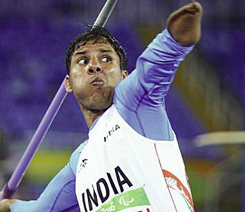India’s team at the Paralympic Games this year not only gave pleasant surprises, it also put into spotlight how much need to be done to encourage promising para-athletes in the country.
THE WORD “Paralympic” originates from the Greek preposition “para” (beside or alongside) together with the word “Olympic”. This was the concept devised by Sir Ludwig Guttmann, an English neurosurgeon in 1948, to provide athletic therapy for people in wheelchairs comprising war veterans and injured civilians.
Sir Ludwig understood the importance of sport as a catalyst for rehabilitation therapy and named it the Stoke Mandeville Games.
However, it was much after World War II, in 1960, that the first Paralympic Games were held in Rome, Italy.
The first Summer Games of the modern Paralympic era were held in Seoul, South Korea in 1988. With 10,000 attendees, 700 wheelchair dancers and performers, over 950 world records were set. Since then, the Paralympic Games are held exactly two weeks after the Olympic Games in the same arenas, same tracks and same Games Village.
India and the paralympic connection
JWhile we remember Abhinav Bindra for his gold medal in Beijing, little did we laud Murlikant Petkar, who won a gold in 50m freestyle swimming in 1972 Germany Paralympics, or Devendra Jhajharia who won first gold in 2004 Athens Paralympics in the javelin throw event. Devendra is an amputee who set a world record in 2004, which is unbeaten even today.
This time around for Rio Paralympics from September 7-18, India sent 17 participants with high hopes from the blind 1,500 metre race by Ankur Dhama, Deepa Malik in wheelchair shot-put and Devendra in javelin throw, amongst others.
But even before these para-athletes started competing in Rio, they were winners in our eyes for defying stereotypes and transforming attitudes of the society. They are the few chosen ones to muster courage to break down social barriers, mindsets and discrimination towards people with physical impairments.
Talk to them and you are hit with some harsh truths and ground realities of how “It does not come easy to train and compete as there aren’t significant facilities for training, despite consistent good performances”. They are not the lucky ones like the able-bodied athletes when it comes to getting jobs or getting financial backing from government, and one can totally forget the corporate sector!
This despite the fact that it was only two years ago at Incheon during Para Asian Games that the Indian para-athletes managed to win 33 medals with three golds. The only thing that inspires our disabled brave hearts is their self-motivation, enthusiasm and the ability to carry on against all adversities.
Hopes against all odds?
It’s not like that no one is coming forward to help our para athletes. Stalwarts such as Abhinav Bindra, Rahul Dravid and Pullela Gopichand are members of the advisory board of a foundation that was set up a few years ago to work at the grassroots level to build and encourage sports culture among school-going children.
And results have shown this time around how India’s Paralympic athletes outpaced their counterparts, winning four medals. This also included the two gold medals in individual events which can any day put our able one’s total number of two in the shadow.
It was a good gesture on the government’s part that all four medalists’ got equal prize money as was announced for the elite athletes. Jhajharia truly deserved a few crores for the kind of achievement which was not repeated by any other Indian till date. His two gold medals, the second after a gap of 12 years, are just an example of his consistent hard work that he has been putting in despite all the physical challenges.
Jhajharia also set a new Paralympic world record with his 63.97-meters javelin throw at the Olympic stadium. Not to forget that his feat in Athens also came with a world record then.
Before him, it was world champion highjumper Mariyappan Thangavelu who, along with another of his practice-mate Varun Singh Bhati, got two medals for India. Thangavelu, of course, made the entire Indian population celebrate for the first gold after Bindra’s 2008 heroics eight years ago.
Deepa Malik on her wheelchair became an inspiration for all back home by becoming the first ever woman to win a Paralympic medal after getting a silver in the women’s shot put competition.
It was only a few days before this that India sent its biggest-ever Olympic contingent to Brazil this year with an optimistic estimate of winning a record 10 medals, or more. In hindsight, one may say that the numbers were exaggerated to get excess funding sanctioned from government coffers. Whereas, for all our para athletes there was literally no funding made available before the Games.
The simple reasoning for a better performance by para athletes could then be that Paralympic athletes tend to train “harder” to prove themselves and have a chance to win cash rewards.
Future perfect
It is believed that the Government of India has now decided to provide extra funding for our bravehearts in order to improve the practice facilities at the ground level. What is actually needed now is to encourage more and more disabled people to take up competitive sports in order to divert their mind to some constructive thoughts.
To make this happen, we need to make our streets, roads and buildings disabledfriendly just like the way Europe and developed countries have done in recent years. In India, no disabled person can step out of the home without a helper for the simple reason that successive regimes have never been sensitive about their needs.
So, to only reach a sporting arena and then even making an entry there, a whole lot of support is needed.

